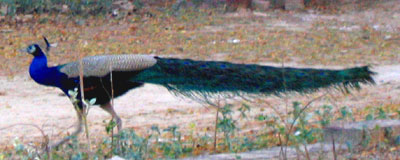 It was 4 o'clock on the morning of 2nd January 2013 when our journey from Rajkot began. It was a long 6 hour drive to Dholavira. For about an hour, we chatted excitedly, but eventually fell asleep till a rumbling noise in our stomach awoke us. As we had carried homemade snack, we halted at a temple on the way, and ate in the vicinity of it. Taking it along was a good idea as there were hardly any shops on the way. Behind the temple we spotted many migratory birds and beautiful peacocks on every dry patch of grass. Listening to them in the morning silence marked the beginning of our journey.
It was 4 o'clock on the morning of 2nd January 2013 when our journey from Rajkot began. It was a long 6 hour drive to Dholavira. For about an hour, we chatted excitedly, but eventually fell asleep till a rumbling noise in our stomach awoke us. As we had carried homemade snack, we halted at a temple on the way, and ate in the vicinity of it. Taking it along was a good idea as there were hardly any shops on the way. Behind the temple we spotted many migratory birds and beautiful peacocks on every dry patch of grass. Listening to them in the morning silence marked the beginning of our journey.
Around 10 am we reached Dholavira. As we got down from the bus, sharp streams of the sun's rays struck our eyes painfully, but thankfully we were carrying sunglasses, cap, water, anticipating this. We had taken along cameras to capture images while exploring the ancient excavated site. Dholavira is one of the 5 major Harrapan cities. It was destroyed 7 times in the 5000 years of its history. It was discovered in 1967 A.D. and the excavation continues slowly even today to bring out more hidden treasures. We were shown the archaeological site by Ravji bhai - our guide. We saw the ancient ruins, including their underground water drainage system, a stadium for celebrations, burial ground etc . The stadium is 1,24,000 square cubic meters. Though covered, we also saw a 10 feet long slab of stone believed to be the first sign-board of the world with inscriptions which has not yet been deciphered. The ancient city also had 16 reservoirs out of which only 3 are excavated. It had a very big citadel. As far as the eyes could follow, we saw mounds of brown and far ahead lay the White Rann of Kutch. 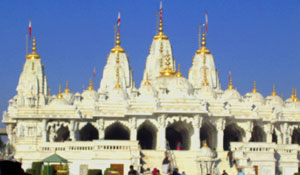 After about an hour of tour of the ruins we went to the Dholavira museum and saw the broken pots, tools used by ancient people, miniature models of games played in the past, jewellery, coins and inscriptions. We sat under the shade of the few huts and had our pre-packed lunch and then headed towards Bhuj, our destination for the next three days. We reached our hotel, Tree Top Residency, around 7 pm, checked in, had hot steaming food and went to bed, thoroughly exhausted.
After about an hour of tour of the ruins we went to the Dholavira museum and saw the broken pots, tools used by ancient people, miniature models of games played in the past, jewellery, coins and inscriptions. We sat under the shade of the few huts and had our pre-packed lunch and then headed towards Bhuj, our destination for the next three days. We reached our hotel, Tree Top Residency, around 7 pm, checked in, had hot steaming food and went to bed, thoroughly exhausted.
Next morning we woke up with a smile on our faces, overjoyed that we had another adventure waiting for us. After breakfast we headed towards the new Swami Narayan temple in Bhuj. It was a magnificent structure. The Swami Narayan temple had exquisite carving of almost all the Hindu Gods. Despite the cold, there were many devotees waiting to offer their prayers.
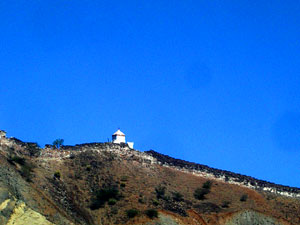 On the way to the Kutch Bhuj museum we saw the Bhutia Dungar enclosed within a wall atop a hillock. Our local guide told us the name reflects the popular belief that this wall was created overnight by 'bhoots or ghosts. At the Kutch Bhuj museum, in excellent condition, there were different sections, with life size exhibits of the different tribes that lived in these areas.
On the way to the Kutch Bhuj museum we saw the Bhutia Dungar enclosed within a wall atop a hillock. Our local guide told us the name reflects the popular belief that this wall was created overnight by 'bhoots or ghosts. At the Kutch Bhuj museum, in excellent condition, there were different sections, with life size exhibits of the different tribes that lived in these areas.
Our next stop was the famed Aina Mehal which was, unfortunately, closed that day. We went to another palace named Prag Mahal which was destroyed due to an earthquake and was pretty worn out. Inside we saw few exhibits. We could tell that the king must have enjoyed hunting animals because there were many stuffed animal heads on display. Now that no one is living in it, birds have taken over most of the castle, with spider webs everywhere. There is a spectacular view of most of Bhuj from the top. On the terrace two huge bells reminded one of a time when they would have been rung. We clicked a lot of pictures here, as the cool breeze stirred our sense of history.
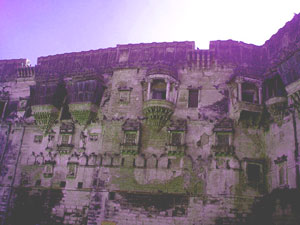 In the early afternoon, we left for Bhujodi which was a handicraft village and a popular shopping site. On arrival, we heard the clinks of the knives and the chiming of the bells. We shopped for souvenirs.
In the early afternoon, we left for Bhujodi which was a handicraft village and a popular shopping site. On arrival, we heard the clinks of the knives and the chiming of the bells. We shopped for souvenirs.
On our third day we were aware that the journey was coming to an end. We got ready for our visit to Kala Dungar and the Indo- Pak border. On the way we passed through the Tropic of Cancer. Some 60 km away from the border we were stopped by the patrol as that was the farthest point civilians were allowed till. We talked to a soldier named Dinesh Chand who was off duty at that time. He told us many incidents about their life. We also saw underground bunkers.After the interesting talk, we climbed the Kala Dungar and saw a sacred temple of Lord Dattatreya. We had good views of the Rann of Kutch. The locals told us that at night they can see the lights of the Indo-Pakistan border. All of it was very fascinating.
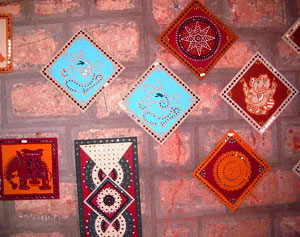 After praying we departed for the Rann of Kutch. We had lunch on the way in a village named Hodka in a traditional hotel. Some of us talked to the villagers about their life. Each family stayed in a mud house called bhoonga. It stays cool in the summer and warm in the winters. The food was very simple but tasty. In the evening we went to the white Rann of Kutch. It was filled with salt left over from the evaporated sea! We saw white blankets of salt under the blue sky. We took a long walk to reach the salt pans. There was a traditional village band wearing colourful clothes in contrast to the white desert, singing songs to the accompaniment of vessels used as musical instruments. Though the lyrics were unfamiliar we enjoyed the music. We went to the Rann Utsav where we saw many stalls displaying different handicrafts of Kutch. The things were same as the ones in Bhujodi but at higher rates. Around 7 pm we left this magnificent place and headed back to our hotel in Bhuj. After enjoying our dinner, we were asleep even before our teachers could give the lightout signal.
After praying we departed for the Rann of Kutch. We had lunch on the way in a village named Hodka in a traditional hotel. Some of us talked to the villagers about their life. Each family stayed in a mud house called bhoonga. It stays cool in the summer and warm in the winters. The food was very simple but tasty. In the evening we went to the white Rann of Kutch. It was filled with salt left over from the evaporated sea! We saw white blankets of salt under the blue sky. We took a long walk to reach the salt pans. There was a traditional village band wearing colourful clothes in contrast to the white desert, singing songs to the accompaniment of vessels used as musical instruments. Though the lyrics were unfamiliar we enjoyed the music. We went to the Rann Utsav where we saw many stalls displaying different handicrafts of Kutch. The things were same as the ones in Bhujodi but at higher rates. Around 7 pm we left this magnificent place and headed back to our hotel in Bhuj. After enjoying our dinner, we were asleep even before our teachers could give the lightout signal.
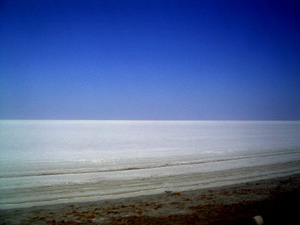 The next day our journey led us to Mandvi, our final destination before we headed home to Rajkot. It was a short 1 hour drive from Bhuj. First we visited the Vijay Vilas palace. It was a truly magnificent palace. The marble work on the pillars matched that on the carpets. The dining table with its great combination of white and black colours made it look more luxurious and fascinating. It was just when we saw Aishwariya Rai,a Bollywood actress, in one of the photos placed on the walls, that we realised that this palace was used to film the movie, Hum Dil De Chuke Sanam. Climbing few steps we reached the terrace from where we could see the surrounding stretches of low growing shrubs. More than the beauty of the palace we were impressed by the silence and the unpolluted atmosphere. There was a fountain and sitting space behind the palace. We heard birds chirping and enjoyed the cool breeze near the fountains.
The next day our journey led us to Mandvi, our final destination before we headed home to Rajkot. It was a short 1 hour drive from Bhuj. First we visited the Vijay Vilas palace. It was a truly magnificent palace. The marble work on the pillars matched that on the carpets. The dining table with its great combination of white and black colours made it look more luxurious and fascinating. It was just when we saw Aishwariya Rai,a Bollywood actress, in one of the photos placed on the walls, that we realised that this palace was used to film the movie, Hum Dil De Chuke Sanam. Climbing few steps we reached the terrace from where we could see the surrounding stretches of low growing shrubs. More than the beauty of the palace we were impressed by the silence and the unpolluted atmosphere. There was a fountain and sitting space behind the palace. We heard birds chirping and enjoyed the cool breeze near the fountains.
 Ae then headed towards the Mandvi beach but did not step into the water. Most of it was badly polluted but we enjoyed listening to the waves crashing on the beach. For entertainment there were camel and horse rides.
Ae then headed towards the Mandvi beach but did not step into the water. Most of it was badly polluted but we enjoyed listening to the waves crashing on the beach. For entertainment there were camel and horse rides.
We boarded our bus to return to Rajkot, with heavy hearts. Though we were eager to see our families, the 4 days spent with friends and teachers will always be cherished by us. The beautiful landscape of Kutch, the heart warming hospitality of the people will remain etched in our hearts for years to come.
 Dholavira-Kutch, the name sounded so musical to our ears when our teachers announced a trip to this magical place as part of the culmination to our history unit Civilizations. Our anticipation knew no bounds when we saw a video as a preview to the trip. White, a colour which gives the feeling of peace and tranquility merged with the vibrant splashes of reds, greens and yellows to emphasise the culture of Kutch. The traditional music was sweet, indeed. We were excited to go on this 4 day trip to behold the true traditions of Gujarat.
Dholavira-Kutch, the name sounded so musical to our ears when our teachers announced a trip to this magical place as part of the culmination to our history unit Civilizations. Our anticipation knew no bounds when we saw a video as a preview to the trip. White, a colour which gives the feeling of peace and tranquility merged with the vibrant splashes of reds, greens and yellows to emphasise the culture of Kutch. The traditional music was sweet, indeed. We were excited to go on this 4 day trip to behold the true traditions of Gujarat.
 It was 4 o'clock on the morning of 2nd January 2013 when our journey from Rajkot began. It was a long 6 hour drive to Dholavira. For about an hour, we chatted excitedly, but eventually fell asleep till a rumbling noise in our stomach awoke us. As we had carried homemade snack, we halted at a temple on the way, and ate in the vicinity of it. Taking it along was a good idea as there were hardly any shops on the way. Behind the temple we spotted many migratory birds and beautiful peacocks on every dry patch of grass. Listening to them in the morning silence marked the beginning of our journey.
It was 4 o'clock on the morning of 2nd January 2013 when our journey from Rajkot began. It was a long 6 hour drive to Dholavira. For about an hour, we chatted excitedly, but eventually fell asleep till a rumbling noise in our stomach awoke us. As we had carried homemade snack, we halted at a temple on the way, and ate in the vicinity of it. Taking it along was a good idea as there were hardly any shops on the way. Behind the temple we spotted many migratory birds and beautiful peacocks on every dry patch of grass. Listening to them in the morning silence marked the beginning of our journey. After about an hour of tour of the ruins we went to the Dholavira museum and saw the broken pots, tools used by ancient people, miniature models of games played in the past, jewellery, coins and inscriptions. We sat under the shade of the few huts and had our pre-packed lunch and then headed towards Bhuj, our destination for the next three days. We reached our hotel, Tree Top Residency, around 7 pm, checked in, had hot steaming food and went to bed, thoroughly exhausted.
After about an hour of tour of the ruins we went to the Dholavira museum and saw the broken pots, tools used by ancient people, miniature models of games played in the past, jewellery, coins and inscriptions. We sat under the shade of the few huts and had our pre-packed lunch and then headed towards Bhuj, our destination for the next three days. We reached our hotel, Tree Top Residency, around 7 pm, checked in, had hot steaming food and went to bed, thoroughly exhausted. On the way to the Kutch Bhuj museum we saw the Bhutia Dungar enclosed within a wall atop a hillock. Our local guide told us the name reflects the popular belief that this wall was created overnight by 'bhoots or ghosts. At the Kutch Bhuj museum, in excellent condition, there were different sections, with life size exhibits of the different tribes that lived in these areas.
On the way to the Kutch Bhuj museum we saw the Bhutia Dungar enclosed within a wall atop a hillock. Our local guide told us the name reflects the popular belief that this wall was created overnight by 'bhoots or ghosts. At the Kutch Bhuj museum, in excellent condition, there were different sections, with life size exhibits of the different tribes that lived in these areas. In the early afternoon, we left for Bhujodi which was a handicraft village and a popular shopping site. On arrival, we heard the clinks of the knives and the chiming of the bells. We shopped for souvenirs.
In the early afternoon, we left for Bhujodi which was a handicraft village and a popular shopping site. On arrival, we heard the clinks of the knives and the chiming of the bells. We shopped for souvenirs.  After praying we departed for the Rann of Kutch. We had lunch on the way in a village named Hodka in a traditional hotel. Some of us talked to the villagers about their life. Each family stayed in a mud house called bhoonga. It stays cool in the summer and warm in the winters. The food was very simple but tasty. In the evening we went to the white Rann of Kutch. It was filled with salt left over from the evaporated sea! We saw white blankets of salt under the blue sky. We took a long walk to reach the salt pans. There was a traditional village band wearing colourful clothes in contrast to the white desert, singing songs to the accompaniment of vessels used as musical instruments. Though the lyrics were unfamiliar we enjoyed the music. We went to the Rann Utsav where we saw many stalls displaying different handicrafts of Kutch. The things were same as the ones in Bhujodi but at higher rates. Around 7 pm we left this magnificent place and headed back to our hotel in Bhuj. After enjoying our dinner, we were asleep even before our teachers could give the lightout signal.
After praying we departed for the Rann of Kutch. We had lunch on the way in a village named Hodka in a traditional hotel. Some of us talked to the villagers about their life. Each family stayed in a mud house called bhoonga. It stays cool in the summer and warm in the winters. The food was very simple but tasty. In the evening we went to the white Rann of Kutch. It was filled with salt left over from the evaporated sea! We saw white blankets of salt under the blue sky. We took a long walk to reach the salt pans. There was a traditional village band wearing colourful clothes in contrast to the white desert, singing songs to the accompaniment of vessels used as musical instruments. Though the lyrics were unfamiliar we enjoyed the music. We went to the Rann Utsav where we saw many stalls displaying different handicrafts of Kutch. The things were same as the ones in Bhujodi but at higher rates. Around 7 pm we left this magnificent place and headed back to our hotel in Bhuj. After enjoying our dinner, we were asleep even before our teachers could give the lightout signal. The next day our journey led us to Mandvi, our final destination before we headed home to Rajkot. It was a short 1 hour drive from Bhuj. First we visited the Vijay Vilas palace. It was a truly magnificent palace. The marble work on the pillars matched that on the carpets. The dining table with its great combination of white and black colours made it look more luxurious and fascinating. It was just when we saw Aishwariya Rai,a Bollywood actress, in one of the photos placed on the walls, that we realised that this palace was used to film the movie, Hum Dil De Chuke Sanam. Climbing few steps we reached the terrace from where we could see the surrounding stretches of low growing shrubs. More than the beauty of the palace we were impressed by the silence and the unpolluted atmosphere. There was a fountain and sitting space behind the palace. We heard birds chirping and enjoyed the cool breeze near the fountains.
The next day our journey led us to Mandvi, our final destination before we headed home to Rajkot. It was a short 1 hour drive from Bhuj. First we visited the Vijay Vilas palace. It was a truly magnificent palace. The marble work on the pillars matched that on the carpets. The dining table with its great combination of white and black colours made it look more luxurious and fascinating. It was just when we saw Aishwariya Rai,a Bollywood actress, in one of the photos placed on the walls, that we realised that this palace was used to film the movie, Hum Dil De Chuke Sanam. Climbing few steps we reached the terrace from where we could see the surrounding stretches of low growing shrubs. More than the beauty of the palace we were impressed by the silence and the unpolluted atmosphere. There was a fountain and sitting space behind the palace. We heard birds chirping and enjoyed the cool breeze near the fountains.  Ae then headed towards the Mandvi beach but did not step into the water. Most of it was badly polluted but we enjoyed listening to the waves crashing on the beach. For entertainment there were camel and horse rides.
Ae then headed towards the Mandvi beach but did not step into the water. Most of it was badly polluted but we enjoyed listening to the waves crashing on the beach. For entertainment there were camel and horse rides.